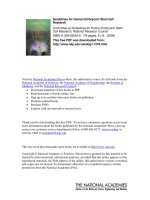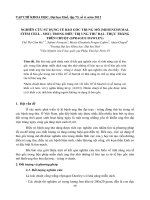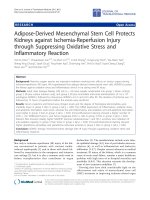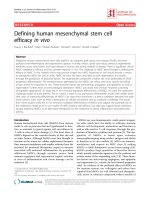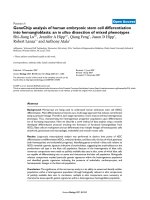Mesenchymal stem cell differentiation on biomimetic surfaces for orthopaedic applications
Bạn đang xem bản rút gọn của tài liệu. Xem và tải ngay bản đầy đủ của tài liệu tại đây (7.84 MB, 221 trang )
MESENCHYMAL STEM CELL DIFFERENTIATION ON
BIOMIMETIC SURFACES FOR ORTHOPAEDIC APPLICATIONS
LIM TEE YONG
(B.Sc., Auckland)
[M.Sc. (Biomedical Engineering), NTU]
A THESIS SUBMITTED
FOR THE DEGREE OF DOCTOR OF PHILOSOPHY
DEPARTMENT OF ORTHOPAEDIC SURGERY
NATIONAL UNIVERSITY OF SINGAPORE
2009
1
Acknowledgements
The work for this thesis has been made possible with much assistance
rendered by various persons to whom I owe my gratitude. Hence, I wish to
sincerely thank the following persons who have assisted me in various ways:
• Dr. Wang Ee Jen, Wilson, for the opportunity to carry out my work in our
laboratory, for the well-established collaboration with the Department of
Chemical and Biomolecular Engineering Laboratory of Prof. Neoh Koon
Gee, for his advice, encouragement and guidance throughout the project,
and for reading my journal manuscripts, conference abstracts and posters,
and this thesis;
• Prof. Neoh Koon Gee for facilitating my access to her laboratory at the
Department of Chemical and Biomolecular Engineering to carry out work
on the fabrication of titanium substrates, and for her advice and guidance;
• Shi Zhilong, Ph.D., for his assistance and guidance in the work on the
fabrication of titanium substrates, and for the advice and discussions on
techniques and the underlying chemical reaction mechanisms, and,
• Poh Chye Khoon, for his assistance in the acquisition of equipment and
materials for my thesis work and the fabrication of titanium substrates, and
for his encouragement and great companionship.
I also wish to express my gratitude to many other persons whose names
are not listed here, who have assisted me in various other ways, and whose
assistance, advice and guidance over the past few years have benefited me
greatly, culminating in the much-needed confidence to undertake this project.
2
Acknowledgement is also given to the following sources:
• Fig. 1.3 is adapted from [1];
• Fig. 1.4 is adapted from [2];
• Fig. 5.3 is adapted from [2, 3];
• Fig. 8.1 is adapted from [3].
3
Contents
Page
Summary of thesis 9
List of tables 10
List of figures 12
List of publications and abstracts derived from work in this thesis 15
Chapter 1 17
General Introduction
The initiative for the modification of bone implants 17
Introduction to biomaterials 19
An overview of biomaterials in orthopaedics 19
The first generation biomaterials 21
The second generation biomaterials 24
The third generation biomaterials 27
Modified biomaterials 28
Choice of biomaterials for osteoblast differentiation 29
Titanium 29
Chitosan 30
Dextran 32
4
Choice of biomaterials for angiogenesis 35
Poly (lactic-co-glycolic acid) (PLGA) 35
Introduction to the biological aspects of implants 38
Mesenchymal stem cells (MSC) 38
Bone morphogenetic proteins (BMP) 39
Vascular endothelial growth factor (VEGF) 42
LPS-CD14/TLR4/MD2 interaction 46
TNF
α
49
S1P 50
Conclusion 52
Chapter 2 54
General materials and methods
Materials 54
Preparation of surface modified titanium substrates 55
Characterization of the titanium substrates 56
Stability and surface density of BMP2 on the 56
surface modified titanium substrates
Culture of bone marrow-derived stromal cells (BMMSC) 57
Culture of bone chip-derived osteoblasts (BC-OB) 58
Culture of human mesenchymal stem cells (hMSC) 59
(Lonza, USA)
Culture of human osteoblasts (hFOB) (ATCC, USA) 59
5
Cell attachment 60
Cell proliferation 60
Flow cytometry 61
Cytotoxicity assay 61
Alkaline phosphatase (ALP) assay 62
Reverse transcription-polymerase chain reaction 63
(RT-PCR)
Alizarin red staining 64
Statistical analysis 64
Chapter 3 65
Human bone marrow-derived mesenchymal stem cells
differentiation into osteoblasts on titanium with surface-grafted
chitosan and immobilized bone morphogenetic protein-2
Introduction 66
Materials and methods 67
Results 72
Discussion 86
Conclusion 89
6
Chapter 4 91
Human bone marrow-derived mesenchymal stem cells
differentiation into osteoblasts on titanium with surface-grafted
dextran and immobilized bone morphogenetic protein-2
Introduction 92
Materials and methods 94
Results 98
Discussion 108
Conclusion 111
Chapter 5 113
Glutaraldehyde crosslinking of BMP2 to chitosan-grafted titanium
substrate
Introduction 114
Materials and methods 116
Results 119
Discussion 122
Conclusion 129
7
Chapter 6 130
Effect of Sphingosine-1-phosphate on LPS-treated human
mesenchymal stem cell-derived osteoblasts cultured on bone
morphogenetic protein-2-linked chitosan-grafted titanium
substrate
Introduction 131
Materials and methods 133
Results 136
Discussion 155
Conclusion 158
Chapter 7 159
Poly lactic-co-glycolic acid as a controlled release delivery device
Introduction 160
Materials and methods 162
Results 169
Discussion 176
Conclusion 181
8
Chapter 8 182
Conclusion
The continual search for advanced orthopaedic 183
biomaterials
The evolving strategies 184
The convergence of scientific disciplines and technologies 187
The contributions of the project 187
Limitations of the project 188
Possible future work 189
Bibliography 190
9
Summary of thesis
A large number of people require surgery, including total joint
replacements, to treat bone and joint degenerative and inflammatory
diseases. Implant-related infections and failure of an implant to
osseointegrate with the bone tissue are common causes of implant failure.
Despite efforts to avoid initial bacterial adhesion on an implant surface,
nosocomial infections do occur. Hence, it is crucial to have the means to
down-modulate the deleterious effects of bacterial endotoxins like
lipopolysaccharide (LPS) on differentiating osteoblasts on the implant
surface while treatment for the infection is given. Implant failure is also
partly attributed to the poor vascularization around the healing bone.
Thus, in the present thesis, the aims are to develop an anti-bacterial,
osteogenic substrate for bone cell differentiation, and to develop an
angiogenic substrate to promote endothelial cell differentiation, as an
adjunct to osteogenesis. To address the concern of opportunistic bacterial
infections at the bone-implant interface, a study is also done to evaluate
the effects of a bioactive lysophospholipid on differentiating osteoblasts
growing on the osteogenic substrate in the presence of a selected bacterial
endotoxin. Taken together, the work in the present thesis forms the basis
for future work to be done in order to take the functionalized substrates
closer to clinical applications.
10
List of tables
Chapter 3
Table 3.1 Flow cytometry analysis of MSC cell surface 76
markers
Table 3.2 Primers used for RT-PCR of bone-related genes 83
Chapter 4
Table 4.1 Primers used for RT-PCR of bone-related genes 106
Chapter 6
Table 6.1 Comparison of TLR4 expression between 137
D1 and D7 of LPS treatment
Table 6.2 Comparison of TLR4 expression between 137
LPS and LPS/S1P treatments on D1
Table 6.3 Comparison of TNFα expression between 140
D1 and D7 of LPS treatment
Table 6.4 Comparison of TNFα expression between 140
LPS and LPS/S1P treatments on D1
Table 6.5 Comparison of Runx2 expression between 143
D1 and D7 of LPS treatment
Table 6.6 Comparison of Runx2 expression between 143
LPS and LPS/S1P treatments on D1
Table 6.7 Comparison of OCN expression between 146
D1 and D7 of LPS treatment
11
Table 6.8 Comparison of OCN expression between 146
LPS and LPS/S1P treatments on D1
Table 6.9 Comparison of RANKL expression between 149
D1 and D7 of LPS treatment
Table 6.10 Comparison of RANKL expression between 149
LPS and LPS/S1P treatments on D1
Table 6.11 Primers used for RT-PCR 151
12
List of figures
Chapter 1
Fig. 1.1 Structural formula of chitosan 30
Fig. 1.2 Structure of fragment of dextran molecule 32
Fig. 1.3 Induction of osteoblast differentiation by BMPs 41
through Runx proteins
Fig. 1.4 VEGF receptor binding and intracellular signaling 45
Fig. 1.5 LPS association with the CD14/TLR4/MD2 48
receptor complex
Chapter 3
Fig. 3.1a Preparation of titanium substrates 69
Fig. 3.1b Photograph of Ti-CS-BMP2 substrates 70
Fig. 3.2 BMP2 adsorption of Ti-CS substrate 73
Fig. 3.3 Cell attachment 75
Fig. 3.4 Cytotoxicity assay 77
Fig. 3.5 Cell proliferation 78
Fig. 3.6 ALP activity 80
Fig. 3.7a RT-PCR gel image 82
Fig. 3.7b Relative levels of bone-related gene expression 82
in BC-OBs and Ti-CS-BMP2 cells
Fig. 3.8a Alizarin Red staining of osteoblasts 85
Fig. 3.8b Alizarin Red staining of untreated BMMSCs 85
13
Chapter 4
Fig. 4.1 Cell attachment 99
Fig. 4.1a Comparison of cell attachment on Ti-CS, 100
Ti-Dex, Ti-CS-BMP2 and Ti-Dex-BMP2 substrates
Fig. 4.2 Cell proliferation 101
Fig. 4.3 ALP assay 103
Fig. 4.4a RT-PCR gel image 104
Fig. 4.4b Relative levels of bone-related genes in 105
Ti-Dex-BMP2 cells
Fig. 4.5a Alizarin Red staining for osteoblasts 107
Fig. 4.5b Alizarin Red staining for hMSCs 107
Chapter 5
Fig. 5.1 Stability of BMP2 on substrate surface 120
Fig. 5.2 ALP activity 121
Fig. 5.3 Structures of glutaraldehyde 124
Fig. 5.4a Glutaraldehyde crosslinking of protein molecules 127
Fig. 5.4b End product of glutaraldehyde crosslinking 127
of protein molecules under alkaline conditions
Chapter 6
Fig. 6.1 Expression of TLR4 138
Fig. 6.2 Expression of TNFα 141
Fig. 6.3 Expression of Runx2 144
Fig. 6.4 Expression of OCN 147
14
Fig. 6.5 Expression of RANKL 150
Fig. 6.6a RT-PCR of TLR4 – gel image 152
Fig. 6.6b RT-PCR of TNFα – gel image 152
Fig. 6.6c RT-PCR of Runx2 – gel image 153
Fig. 6.6d RT-PCR of OCN – gel image 152
Fig. 6.6e RT-PCR of RANKL – gel image 154
Chapter 7
Fig. 7.1 Illustration of the PLGA-VEGF substrate 164
Fig. 7.2 Photograph of the PLGA-VEGF substrate 164
Fig. 7.3 Degradation rate of PLGA 170
Fig. 7.4 Release kinetics of VEGF from the PLGA-VEGF 172
substrate
Fig. 7.5 Immunofluorescent staining of endothelial cells 174
Fig. 7.6 Endothelial cell capillary network formation on 175
Matrigel
Chapter 8
Fig. 8.1 The convergence of scientific disciplines and 187
technologies enables smart and instructive
strategies for tissue regeneration
15
List of publications and abstracts derived from work on this thesis
Journals
T. Y. Lim, W. Wang, Z. Shi, C. K. Poh and K. G. Neoh, Human bone marrow-
derived mesenchymal stem cells and osteoblast differentiation on titanium with
surface-grafted chitosan and immobilized bone morphogenetic protein-2, J Mater
Sci Mater Med 20(1) (2009), pp. 1-10.
T. Y. Lim, C. K. Poh and W. Wang, Poly (lactic-co-glycolic acid) as a controlled
release delivery device, J Mater Sci Mater Med 20(8) (2009), pp. 1669-1675.
T. Y. Lim, C. K. Poh, Z. Shi, K. G. Neoh and W. Wang, Effect of Sphingosine-1-
phosphate on LPS-treated human mesenchymal stem cell-derived osteoblasts
cultured on bone morphogenetic protein-2-linked chitosan-grafted titanium
substrate, Under review.
Abstracts
T. Y. Lim, W. Wang, Z. Shi, C. K. Poh and K. G. Neoh, Human bone marrow-
derived mesenchymal stem cells and osteoblast differentiation on titanium with
surface-grafted chitosan and immobilized bone morphogenetic protein-2, 2
nd
International Congress on Stem Cells and Tissue Formation, 2008, Dresden,
Germany.
16
Chapter 1
General Introduction
The initiative for the modification of bone implants
Bone and joint degenerative and inflammatory problems affect a large
number of people worldwide. It is believed that the number of afflicted people will
continue to rise. These diseases usually require surgical treatment, including
total joint replacements in cases of severe degeneration of natural joints.
Orthopaedic biomaterials are used in the fabrication of implantable medical
devices to substitute, replace, or repair bones, cartilage or ligaments and
tendons. However, current bone implants have a limited lifespan. An average
implant lasts only about one to two decades. Implant failure can result from the
repeated cyclic mechanical stress of motion, which fragments the cement used to
secure the implant to the bone. Biomaterial debris around the bone-implant
interface can cause osteolysis, a condition in which bone is gradually resorbed.
Although osteolysis is a low-grade form of bone resorption, it eventually results in
the loosening of an implant. Revision surgery to replace the failed implant with a
new one is a painful and costly procedure for the patient. Besides the
inconvenience of revision surgery, each replaced implant also has a shorter
lifespan than the one which immediately precedes it. Although non-cemented
implant components have been used to get around the problem of cement
failure, the success of this approach is not consistent. This technique relies on
the physical modification of the implant surface to render it porous, in an attempt
to encourage bone growth into the porous surface. Implant components are
17
fabricated from titanium, but bone often recedes from the cementless
components as well.
Bacterial infection of a bone implant surface is another major cause of
implant failure. During surgical insertion of an orthopaedic implant, bacteria from
the patient’s own skin and mucosa can enter the wound site. Upon adhesion on
the implant surface, the bacteria secrete a thick extracellular matrix and this
leads to the formation of a bioflim. The protective biofilm delays the action of
antimicrobial agents, making the bacteria within the biofilm very resistant to host
defence mechanisms and antibiotics [4]. Bacterial infection at an implant site can
eventually result in localized bone destruction, leading to implant failure.
Furthermore, the evolution of antibiotic-resistant bacteria limits the availability of
effective antibiotics for the treatment of implant-related infections.
The failure of implant to osseointegrate with the host bone tissue and
bacterial infection are the main reasons for much research into making implant
surfaces that retard initial bacterial adhesion and promote bone formation at the
tissue-implant interface. The concept of using a cementless component bone
implant, despite its present short-comings, is an attractive option to pursue in the
quest for a longer-lasting prosthesis. To this end, researchers have explored the
idea of coating an implant surface with a bone-growth stimulating factor to
encourage bone attachment onto the surface. However, such biomimetic
coatings have to be firmly attached to the implant surface to be resistant to any
abrasions that the prosthesis may be subjected to during surgery. The coating
must also be resistant to the wear and tear of repeated cyclic mechanical stress,
18
and not delaminate at the implant metal interface. Due to the highly corrosive
environment of the human body, implantable devices consequently need to fulfill
stringent requirements so that they do not corrode and release cytotoxic by-
products. A biomaterial also must not induce an immunogenic response when it
is implanted in a host. Undesirable host response to an implant can result in
implant failure due to host rejection of the prosthesis. The process of bone
regeneration is a unique one in the human body, in which angiogenesis plays a
role. A chapter in this thesis is dedicated to the surface functionalization of poly-
(lactic-co-glycolic acid) (PLGA) substrates with an angiogenic growth factor, to
promote the differentiation of endothelial cells. Thus, in this thesis the purpose of
surface modification is to render the titanium substrates osteogenic and the
PLGA substrates angiogenic, as an adjunct to osteogenesis.
Introduction to biomaterials
An overview of biomaterials in orthopaedics
The choice of biomaterials for use in an implant is a crucial process that
involves rigorous tests to assess their mechanical and biochemical properties,
and their biological interaction with tissues. Hence, along the guidelines of
mechanical properties and biocompatibility, the development of orthopaedic
biomaterials conceptually evolved over three generations. A review of the
evolution of biomaterials over three generations will allow a better appreciation of
the initiative and the subsequent aims of the work undertaken for this thesis. The
19
wide range of orthopaedic biomaterials available necessitates the discussion to
be focused on a few selected metals and biodegradable materials.
20
The first generation biomaterials
The first generation of orthopaedic biomaterials was mainly bioinert
materials. This generation of biomaterials was designed to match the physical
properties of the replaced tissues, and would not elicit an immune response [5].
Metallic materials of this generation that were successfully employed in
orthopaedic applications were stainless steel and cobalt chrome-based alloys.
Stainless steel implants were used in movable joints replacement parts but their
poor wear resistance generated wear debris which resulted in osteolysis and
local bone destruction, eventually leading to implant loosening. Thus, stainless
steel was replaced by the wear resistant cobalt chrome alloys for the fabrication
of replacement parts that were subjected to constant cyclical stress. Cobalt-
chrome-molybdenum (Co-Cr-Mo) alloys have exceptional corrosion resistance
[6]. However, it is difficult to fabricate complex shapes using this alloy. Another
problem is the occurrence of large grain sizes despite the use of special casting
techniques. Notwithstanding these disadvantages, Co-Cr-Mo alloys possess
properties superior to stainless steel. Co-Cr-Mo alloys have higher intrinsic
resistance to corrosion compared to stainless steel. Metallic transfer which
results in galvanic corrosion, which is thought to occur between surgical tool and
implant is much less for Co-Cr-Mo implants than for stainless steel ones.
Surface damage to the implant which inevitably occurs during the surgical
insertion of the implant can lead to corrosive damage in stainless steel implants
but does not seem to similarly damage Co-Cr-Mo ones. However, the elastic
modulus of these metals is higher than that of cortical bone. Hence, when
21
placed in contact with cortical bone, these metals will take much of the load that
originally acts on the bone, resulting in reduced loading on the bone. This is
known as the load sharing principle of the composite theory, and results in stress
shielding. Bone is a natural composite material comprising an organic phase,
made up mainly of Type I collagen, and a mineral phase, made up of
hydroxyapatite. According to Wolff’s Law, bone that is subjected to stresses
higher than baseline physiological levels responds with osteogenesis.
Conversely, when subjected to stresses lower than physiological levels, bone
atrophy occurs as the bone resorbs, eventually leading to implant failure.
Although hydroxyapatite, which has the chemical formula, Ca
10
(PO
4
)
6
(OH)
2
, does
not have the mechanical strength to be used for load bearing purposes, it is often
used as a ceramic coating on metallic implant surfaces. Being a bioactive
material, a hydroxyapatite coating on the implant surface may serve to enhance
osseointegration between implant and bone [7].
The use of titanium and its alloys in orthopaedics became popular after
Branemark discovered the phenomenon of osseointegration [8]. Titanium and
its alloys can tightly integrate into bone, greatly increasing the long-term
behaviour of titanium-based implants and reducing the risks of implant failure.
Titanium is a strong metal, and is very resistant to heat and corrosion. However,
it is very difficult to machine into desired shapes. Its hardness, together with its
high chemical reactivity with air, and other factors, has made titanium
components very costly. Nevertheless, titanium, due to its biocompatibility, in
addition to its strength and excellent resistance to corrosion, is used in the
22
fabrication of components in implants and prosthetics. There are several types
of titanium alloys which have been developed for use. The most commonly used
titanium alloy is Ti-6Al-4V. Another type of titanium alloy is Ti-4Al-4Mo-2Sn-
0.5Si, which is less commonly used. Titanium and titanium alloys possess
characteristics which make them a popular choice as a biomaterial for
orthopaedic applications. Their hardness confers strength which allows them to
be used for load-bearing applications. They also possess bend strength and
fatigue resistance, which are important in load-bearing structures that are
constantly subjected to the cyclic stress of motion. Ti-6Al-4V has a lower density
than other metals that are used as biomaterials, making it comparably lighter. As
an example, Ti-6Al-4V has a density of 4.40 g cm
-3
while cobalt-chrome alloy has
a density of approximately 8.5 g cm
-3
. In terms of their elastic modulus, Ti-6Al-4V
has a magnitude of 106 GPa while that of cobalt-chrome alloy is 230 GPa.
Elastic modulus is a measure of a substance’s tendency to be deformed non-
permanently, that is, elastically. A substance with a low elastic modulus is
flexible. A rigid biomaterial may cause bone atropy due to stess shielding and
interference with blood circulation, which causes the bone to weaken. Hence, Ti-
6Al-4V would be a more suitable choice than cobalt-chrome alloys for use in
regions of the body which experience bending stresses. From a biomechanical
perspective, Ti-6Al-4V would thus be less likely to cause bone atrophy and
resorption. Although titanium has excellent corrosion resistance, its wear
properties are poor. There are concerns that wear debris from titanium-based
joint replacement implants could be cytotoxic or cause tissue reactions [9, 10].
23
A common feature of first generation biomaterials is the adsorption of
unspecific proteins on the surface of the materials. A diverse array of unspecific
proteins thus elicits the unspecific signaling to the cellular environment.
Ultimately, a fibrous layer forms and encapsulates the implant. Thus, in the
second generation of biomaterials, the aim is to develop bioactive interfaces
which elicit a specific biological response.
The second generation biomaterials
The second generation of biomaterials is characterized as bioactive
materials which interact with the biological environment to induce specific
responses, as well as resorbable materials which support tissue development
while progressively degrading into harmless products. The development of
bioactive surfaces which promote mineralization and bonding between bone and
implant is a common functionalization process to enhance osseointegration.
Although no metallic surface is bioactive per se, metals can be rendered
bioactive by anchoring bioactive molecules onto their surface (surface
functionalization). Metals can be functionalized using methods of physical or
chemical modification of the surface. Physical surface modification includes
electrophoretic deposition, plasma spraying and laser ablation [11-13]. Various
chemical methods have also been developed to activate a material surface.
Kokubo et. al. developed a thermochemical treatment which results in the
formation of a thin titanate layer on a material surface that is able to form a dense
bone-like apatite layer when immersed in a physiological medium [14]. Various
24
other chemical treatment methods including etching with hydrogen peroxide have
also been developed [15, 16].
Resorbable polymers are the focus of the second generation of polymers.
These biodegradable polymers undergo a controlled chemical breakdown and
the polymer chains are resorbed. Examples of biodegradable polymers are
polyglycolide (PGA), polylactide (PLA), poly(ε-carprolactone) (PCL), chitosan and
hyaluronic acid. Kulkarni et. al. introduced the concept of biodegradable
polymers, and these materials have been used in many orthopaedic applications
such as repair of bone fractures and bone substitution [17, 18]. These polymers
are also used for making sutures, screws and pins [19]. The use of
biodegradable polymers in orthopaedic application has several advantages over
metallic ones. As the polymers gradually degrade, they help to reduce the
problem of stress shielding that are typical of metallic implants. Biodegradable
polymers also eliminate the need for subsequent surgeries that may sometimes
be necessary to remove metallic implants. Finally, biodegradable polymers
enable post-operative diagnostic imaging without artefacts, unlike metals.
Due to the hydrolytic sensitivity of biodegradable polymers, moisture must
be avoided during thermal processing of the polymers [20]. The biodegradation
of these polymers is mainly initiated by hydrolysis, although enzymatic activity
may to a lesser extent, play a role [21, 22]. Various factors control the
degradation times of the polymers. The molecular weight of the polymer,
polymer crystallinity, monomer concentration, porosity, geometry and location of
the implant are factors that determine how quickly a polymer will degrade. In
